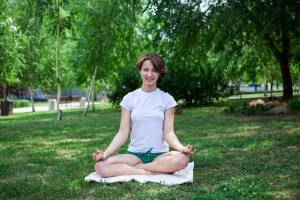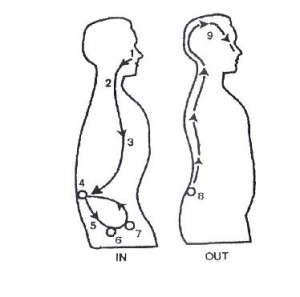I wanted to write a basic “how-to” article on meditation. I’ve kept a steady practice of 15-30 minutes a day for the past few months, and it’s amazing how much better it makes me feel.
Research is constantly being done about meditation. We’re learning how it changes the brain, reduces stress, and other health and scientific benefits. Doctors, scientists, and psychologists alike will tell you that it will physically, emotionally, and mentally change your life for the better.
There is no “one-size-fits-all” way to meditate. It’s a deeply personal practice, so it’s important to realize that you just have to do what works best for you. Go with the flow. Follow your inner guidance.
That being said, there are important things to remember when you meditate – kind of like some basic ground rules to know before you begin. Then you can experiment with different techniques and see what works best for you.
1. Get comfortable in a peaceful place.
It’s very important to be in a place that brings you comfort and solace when you meditate. That can be your bedroom, your couch, out in nature, in the darkness, in the sunshine, or in a bubble bath (my personal favorite). You can even do it at your desk at work or while sitting in class if you need to. Though a beautiful, serene space would be preferred, you really can meditate anywhere, anytime.
 2. Take the traditional lotus position or whatever is comfortable for you.
2. Take the traditional lotus position or whatever is comfortable for you.
The traditional meditation pose is the lotus position (pictured on the right). It’s much more comfortable to sit on a pillow in this position, especially for beginners. (You want to keep your hips higher than your knees, at least that’s what I’ve found to be most comfortable.) Simply sit cross-legged with your hands on your knees, or tops of thighs, whatever is comfortable. You can also lay your hands in your lap, place them at your heart, or above your head. Some people like to lie down while they meditate (just make sure you don’t fall asleep!). My lower back starts to kill me after a while, so I’ll lay down halfway through. You can also sit in a chair or even stand if you want. Again, just experiment with different things and do whatever comes naturally for you!
3. Focus your attention inward.
This is where you focus on two important things – breath and posture. These are the main things to remember regardless of what else you implement into your practice. Meditation is a time to slow down, focus on your breath, and connect with yourself. We are a society that has forgotten how to slow down and breathe. Most of us are shallow breathers 99% of the time, and that is what contributes to high blood pressure, increased heart rate, stress, etc.
Breath is most important to remember when meditating, and good breath comes from good posture. So sit up tall with your back straight. Make sure your shoulders are back and down, expanding and opening the chest. You breathe through your belly (diaphragm), not your chest, so make sure your shoulders are relaxed and still and your belly is going in and out.
 Take deep breaths through the belly, in and out through your nose. When you breathe in, expand the stomach and diaphragm, sucking air in. And then when you breathe out, squeeze the belly in and push the air out through your nose. I find the visual to the left a good representation of how you should think of directing the breath as you breathe. As you breathe in, picture that air and energy going down the front of your body. As you breathe out, picture it going up your spine, filling your head, and then out through your nose.
Take deep breaths through the belly, in and out through your nose. When you breathe in, expand the stomach and diaphragm, sucking air in. And then when you breathe out, squeeze the belly in and push the air out through your nose. I find the visual to the left a good representation of how you should think of directing the breath as you breathe. As you breathe in, picture that air and energy going down the front of your body. As you breathe out, picture it going up your spine, filling your head, and then out through your nose.
Breath is the life force that keeps us going. Our bodies need that breath circulated within to be our best – in the best health, the best mood, the best vibration, the best reality.
4. Get into what I like to call “Meditation Mind”.
Quieting the mind is probably the number one challenge people have when meditating. And it’s probably the number one thing that keeps people from meditating. I’ve learned that expecting yourself to completely quiet your mind and transcend the first time you meditate is ridiculous and unrealistic. What’s important is that you acknowledge all the thoughts and images flowing through your brain and then release them. When you start wondering about what you’re going to have for dinner or what things on your to-do list you still haven’t checked off, acknowledge that you’re thinking that, and then let it go. Maybe put the thought in a bubble and watch it float away. Then return yourself to center, refocus your breath and posture, and be still. It helps to direct your gaze to your forehead when you notice your mind drifting. This is the location of your pituitary gland which regulates all other glands in your body. It helps shift your focus back to why you are meditating in the first place – to connect with self and benefit the mind, body, and soul.
There are several techniques for quieting in the mind, including mantras, affirmations, tonal exercises, guided imagery, etc. which I will talk about in more detail in tomorrow’s post!
For now, take what you’ve learned and meditate today. Try it sitting for a half hour (or just five minutes – baby steps). Focus on breath, posture, and attention. And I’ll talk more tomorrow about enhancing the meditation with the techniques listed above.
In peace and stillness – Namaste.


Meditating in a bubble bath is my favorite too! It’s the best way to go really deep for me. And I love the diagram, I focus on my breath moving through my body in that pattern any time I feel the need to center myself.